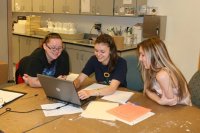From Management to Engagement
As educators, we are always looking for management strategies to try in the classroom. Note I said "strategies" -- not "solutions."
Many Edutopia bloggers have written about strategies and ideas for classroom management. I've also written a blog on PBL management strategies, but many of those same strategies can be used in non-PBL contexts.
When picking strategies, we have to know that because they are strategies, some may not work. But we can still build our toolkit so that we have something to try in any context.
However, there is a larger, more important issue to consider before venturing into management strategies to solve a problem in the classroom: engagement! I hinted at this in my PBL management post, but the best strategy for management issues is engaging curriculum and instruction. When I experience frequent management issues in my classroom, I first look to myself: "What is my role in creating this situation? Why are my students not engaged?" I ask.
It is crucial to focus on engagement rather than management. In fact, Daniel Pink articulates this point when he talks about the workforce. It still rings true: "Management is good if you want compliance, but if you want engagement, self-directed is better."
Here, Pink is talking about the three things that are needed for engagement, but they still hold true when we think about our classrooms and what we are asking of our students.
Autonomy
If you want your students to be engaged, facilitate self-directed activities and learning models. In PBL models, students are encouraged to take ownership of their work, but you can create self-direction through flipping the classroom, differentiating instruction and other best practices. Create spaces in your classroom where students direct their own learning. Use goal setting sheets, logs, reflection, and planning forms so you can hold students accountable to the learning, while still allowing autonomy.
Mastery
Our students like getting better at stuff. This "stuff" is skills, knowledge of content, and the like. Obviously, we have important content our students need to master, but we have to let students see the process of improvement. To engage students in mastery, we have to create rubrics that show the progress from novice to master. We can also create quality indicators for those objectives that students can understand, and we have to reward students for their work with performance and public celebration.
Purpose
Students need to find purpose in their work, and teachers need to create authentic contexts, tasks, and audiences for their students to display their work. Create units or projects that have an authentic purpose and audience. Students may or may not do things for me the teacher, but when experts are part of the process and product, they will engage in the work because it matters. Have students create products that have real impact. Use principles of the flat classroom to collaborate with classrooms across the world to solve problems together. The possibilities for purposeful work are endless.
Engage Students in the Classroom
As you start your new school year, find ways to create spaces where students have autonomy, pursue mastery, and engage in tasks that have meaning. Start small at first, because as it may be challenging for you as the teacher, it may be the same for students. Often, students are disempowered in their learning and do not have the opportunity to engage in these three strategies for engagement.
Empower your students by focusing on engagement, and the management issues will dissipate.
